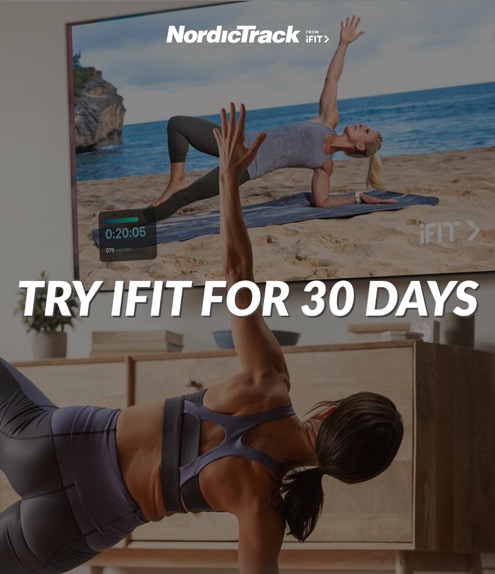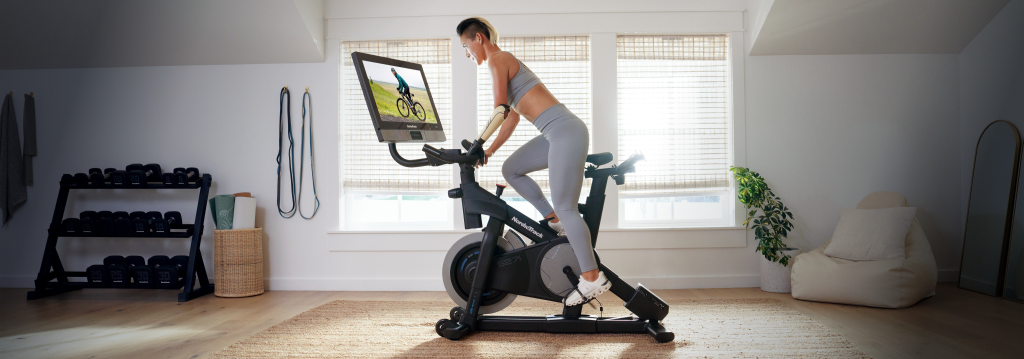
Ready to give your home gym a pedal-powered upgrade? We know, the journey to finding the best exercise bike can be long and arduous, a bit like a Tour de France — without the picturesque French countryside. But fear not; we’re here to help steer you in the right direction.
If you’re short on time, though, consider these key takeaways before you start shopping:
1. Benefits of Exercise Bikes: Improved cardiovascular health, muscle strengthening, calorie-burning, low-impact workouts, and versatile workout routines.
2. Types of Exercise Bikes:
- Upright Bikes: Mimics outdoor cycling.
- Recumbent Bikes: Offers added back support.
- Studio Bikes: Suitable for intense cycling workouts.
3. Fitness Goals: Upright or studio bikes have the potential to burn calories, while recumbent bikes may improve strength and muscle tone.
4. Key Features:
- Resistance Types: Options between magnetic or air resistance.
- Adjustability: The ability to customize seat and handlebars.
- Tech Add-ons: Advanced features like touchscreens, heart rate monitors, or virtual workouts.
5. Budget: Balance between quality and affordability.
6. Space Consideration: Make sure the bike fits in your space without getting in the way.
Read on to learn all about exercise bikes and how to choose the best exercise bike to meet your lifestyle and fitness goals!
Why an Exercise Bike, You Ask?
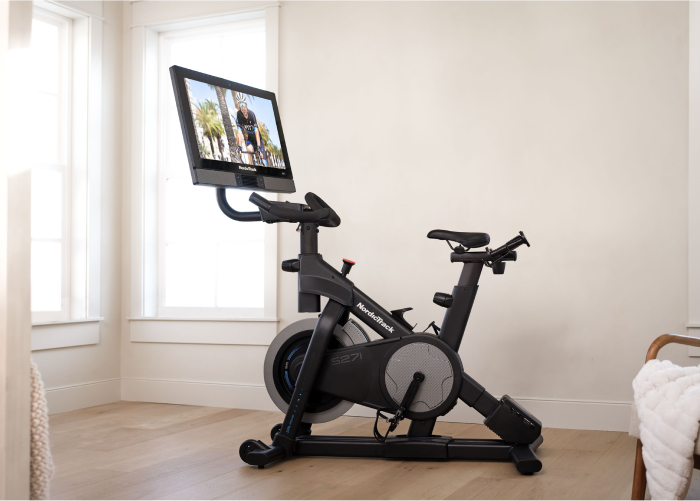
First off, let’s tackle the question of “How to choose an exercise bike?” by looking at its array of advantages. If you’re wondering, “What are the benefits of using an exercise bike?” or “How do I choose the best exercise bike?” these stationary stallions pack a punch in terms of benefits.
- Improved Cardiovascular Health: Just like any other aerobic activity, pedaling on an exercise bike gets your heart rate up, promoting better heart health. [1] Consistent cycling may help improve your lung capacity, boost circulation, and reduce the risk of cardiovascular diseases.
- Strengthened Muscles: It’s not just about the cardio; your muscles get a workout too. Cycling targets the legs, glutes, and core, toning and strengthening in the process. [2]
- Calorie Burning: Depending on the intensity, you may burn anywhere from 200 to 600 calories in an hour. [3] Now, that’s an efficient way to maintain or work towards your desired weight.
- Low-impact: High-intensity, low-impact — that’s the exercise bike’s mantra. They’re kinder on the lower body, making them potentially suitable for all fitness levels. [4]
- Super Versatile: With an exercise bike, workouts can fit seamlessly into your lifestyle. Want a leisurely cycle? No problem. Feeling the urge to push your limits? Ramp up the resistance and speed for a high-intensity session. Whether it’s morning, noon, or night, rain, or shine — your exercise bike is ready when you are.
Next time you’re weighing the benefits of adding an exercise bike to your routine, remember: it’s more than just a stationary piece of equipment. It’s a gateway to a healthier you!
Types of Exercise Bikes and Who They’re Suited For
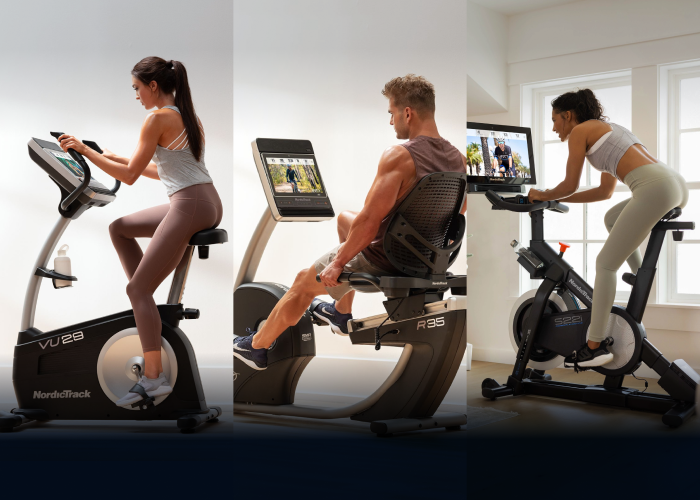
“How do I choose the best exercise bike?” While you’ve decided an exercise bike is in your fitness future, with so many options, it’s essential to know how to choose an exercise bike that fits your needs. Let’s dig deeper into each type and see which might be the best fit for your workout vibes:
Upright Bikes:
- What is it? Think of the bikes you used to ride in the park, just without the moving scenery. The upright bike positions the user over the pedals in a conventional bicycle stance.
- Who’s it for? If you’re seeking that authentic bike-riding experience without the unpredictability of outdoor elements, this one’s your match. It’s perfect for a casual exerciser but can still offer challenging workouts for the more advanced riders.
Recumbent Bikes:
- What is it? These let you kick back, literally. With a larger seat and supportive backrest, it allows you to pedal out front in a reclined position. Think of it as the lounge chair of exercise bikes.
- Who’s it for? Those wanting a less strenuous workout will find these particularly appealing. Plus, they’re great for those just getting started with exercise or older adults who desire comfort alongside their calorie burn.
Studio Bikes:
- What is it? Born from those high-energy studio classes, these bikes are built for performance. They have a heavy flywheel, adjustable resistance, and a design that simulates the posture of road cycling.
- Who’s it for? If you thrive on high-intensity workouts, studio bikes are your ticket. They’re perfect for serious cyclists and those looking to push their limits with heart-pounding workouts.
The best bike for you truly depends on your personal fitness goals, physical needs, and preferred workout style. Whether you’re looking to recreate outdoor rides, focus on comfort, dive deep into intense sessions, or multitask your muscles – there’s a bike waiting for you to hop on and ride!
Considering Your Fitness Goals
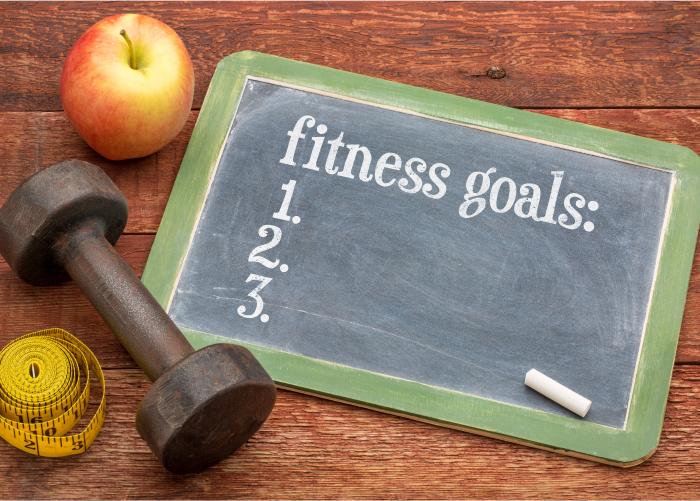
When we talk about fitness, it’s not a one-size-fits-all situation. Your unique goals are the compass guiding you toward the right type of equipment. Let’s break down how different exercise bikes align with various fitness targets, plus our picks for the best exercise bikes.
Calorie Burn:
- Why it matters: The key to burning calories is creating a calorie deficit, where you burn more calories than you consume. Cardiovascular exercises like cycling may burn calories and rev up your metabolism. [5]
- Bike recommendation: While all exercise bikes can contribute to this, upright and studio bikes are typically the frontrunners. Why? They allow for more intense, sweat-dripping sessions that mimic the challenges of outdoor cycling.
Muscle Tone and Strength
- Why it matters: Cycling engages multiple muscle groups, making it a beneficial activity for both fat loss and muscle definition.
- Bike recommendation: Recumbent bikes, with their laid-back design, focus more on the leg muscles. They offer a unique resistance that can help define and tone these areas.
Endurance Building
- Why it matters: Increasing your endurance helps you perform activities for longer periods without getting winded. It also enhances your overall fitness and stamina. [6]
- Bike recommendation: All exercise bikes can assist in this area, but studio bikes, with their capability for extended, resistance-heavy sessions, are especially beneficial.
In essence, while all exercise bikes offer fantastic benefits, understanding your primary fitness goals can lead you to the best fit. Whether it’s calorie burn, muscle toning, or endurance, there’s a stationary chariot waiting to champion your cause.
Features to Pedal Towards
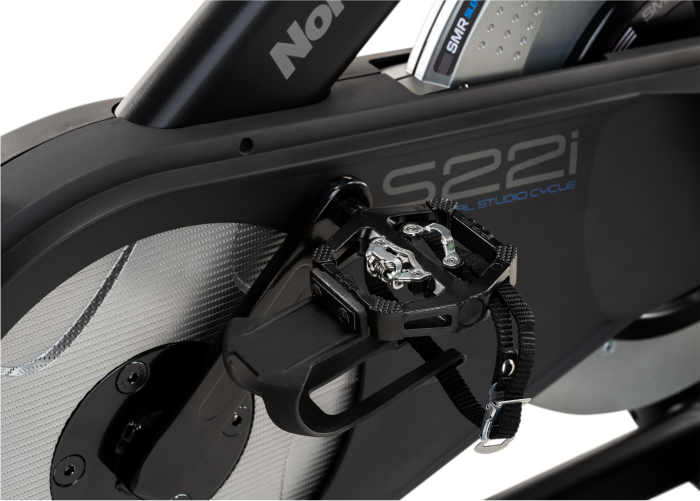
Navigating the realm of fitness equipment, especially when determining “how to choose an exercise bike?” can be daunting. What are the core features, and what benefits can they offer? This handy guide will help streamline your decision, highlighting essential aspects to consider for an optimal cycling experience.
Resistance Types – The ‘How Hard Do I Work?’ Factor:
- Magnetic Resistance: This is the silent operator of the resistance world. Magnetic resistance operates, as the name suggests, on magnets, offering a frictionless, smooth ride. Perfect for those who love a quiet environment or live in shared spaces. [7]
- Air Resistance: This one’s intuitive – the harder you pedal, the more resistance you face. It’s like cycling against a gust of wind; the faster you go, the stronger the wind pushes back. Great for those who love a challenge and wish to intensify their workouts progressively.
Adjustability – Tailoring the Ride for You:
- Seat Adjustments: Look for bikes where the seat height and position can be tweaked. This may help ensure you maintain a good posture, maximizing the workout impact while minimizing risk of injury. [8]
- Handlebar Tweaks: Adjustable handlebars cater to different arm lengths and preferred postures. Whether you’re leaning forward for an intense ride or sitting back for a light pedal, the handlebars should accommodate you.
Techy Add-ons – The Modern Rider’s Delight:
- Interactive Screens: From tracking your calories burned to the distance covered, modern displays offer a plethora of data. Some even come with touchscreen capabilities and can stream on-demand workouts.
- Heart Rate Monitors: Essential for those keeping an eye on their cardiovascular health or aiming for target heart rate zones. They provide real-time feedback on the intensity of your workout.
- Virtual Workouts: Ever wanted to cycle through the streets of Paris or the countryside of Tuscany from your living room? Some exercise bikes offer virtual workouts, complete with HD visuals and real-world terrain simulations. It adds an element of adventure and fun to your regular routine.
Speaking of virtual workouts and interactive features, iFIT, a leading paid-subscription fitness platform, integrates seamlessly with many NordicTrack exercise bikes. So, dive into a world of immersive training, explore breathtaking destinations with expert coaches, and tap into a community that fuels your passion for fitness, all from the saddle of your bike!
So, while the core function of an exercise bike remains consistent, the features you choose can greatly enhance your experience. Think of them as the gears on a bike, allowing you to shift your workout from a leisurely coast to a mountainous challenge as you ride in comfort and style.
Let’s Talk Budget

Just as we pedal at different intensities, we all have different financial thresholds when it comes to splurging on fitness gear. Setting a budget isn’t just about preventing post-purchase guilt; it’s about ensuring value for every dollar (or penny!) spent.
On one end, we have the luxury models – the Rolls-Royces of exercise bikes, laden with every tech perk imaginable. And at the other, simpler, no-frills machines that still get the job done.
But here’s the golden nugget of advice: aim for the sweet spot. This is where quality meets affordability. Brands, bells, and whistles aside, ensure the bike aligns with your core needs and fitness goals. After all, the best investment is one that gets you pedaling consistently!
Making Room
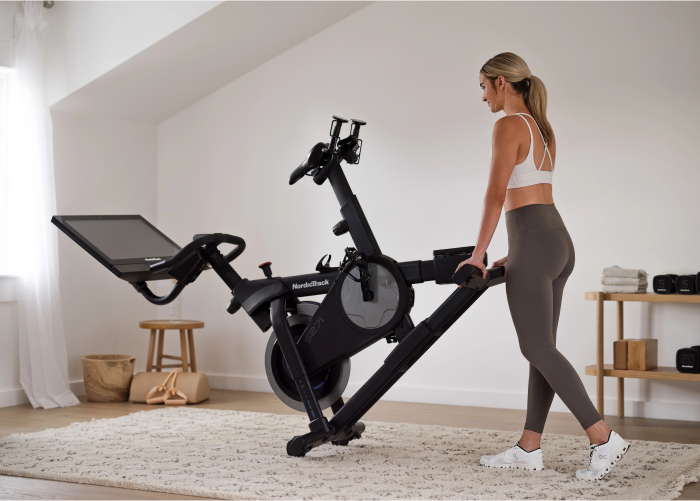
As exciting as it is to envision yourself pedaling towards your fitness goals, ensuring your new exercise bike fits your lifestyle, and your living space is crucial. Starting your fitness journey only to realize your bike’s taken over your favorite reading nook? Not the best motivation boost!
- Size Does Matter: Exercise bikes, like shoes, come in all sizes. While some models are compact and perfect for apartment living, others might be larger, catering to a more extensive range of features. Before you click ‘buy,’ grab a measuring tape and envision where your new workout buddy will reside.
- Mobility and Storage: Some bikes are designed with wheels, making them easy to move around. This feature is a lifesaver if you plan on storing your bike when it’s not in use or if you enjoy changing your workout scenery within your home.
- Design Aesthetics: An often-overlooked aspect is how the bike looks. If it’s going to be a permanent fixture in your living space, you might want one that complements your decor. A bike that visually pleases you is more likely to get you hopping on it rather than using it as a makeshift laundry rack.
While an exercise bike is an investment in your health, it should seamlessly integrate into your home environment. It’s meant to elevate your daily routine, not complicate it.
The Bottom Line
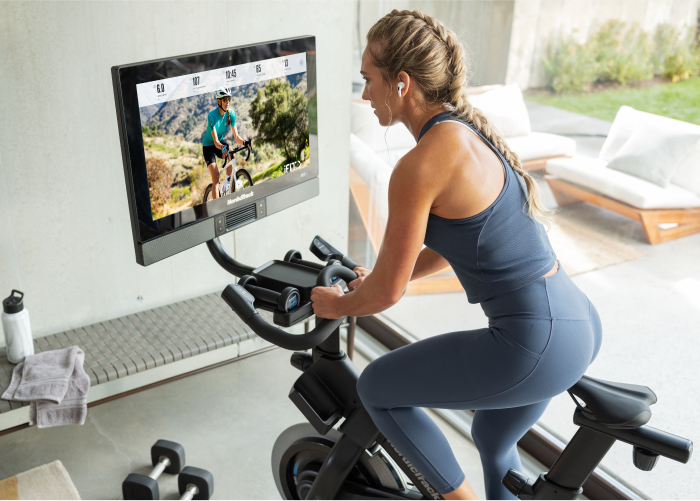
Choosing the best exercise bike to meet your fitness goals doesn’t have to be a wheelie big challenge. Still pondering, “How do I choose the best exercise bike?” Consider your needs, and check out some great tips from our exercise equipment guide to get you pedaling your way to glory.
These resources will help in your quest on “How to choose the best exercise bike for your fitness goals?” And remember, no matter which bike you choose, it’s all about the journey (even if it’s stationary)!
Footnotes
- Haskell WL, Lee IM, Pate RR, et al. Physical activity and public health: updated recommendation for adults from the American College of Sports Medicine and the American Heart Association. Circulation. 2007;116(9):1081-1093.
- Jorge M, Hull ML. Analysis of EMG measurements during bicycle pedalling. Journal of Biomechanics. 1986;19(9):683-694.
- Swain DP, Franklin BA. VO2 reserve and the minimal intensity for improving cardiorespiratory fitness. Medicine & Science in Sports & Exercise. 2002;34(1):152-157.
- Andersen LB, Schnohr P, Schroll M, Hein HO. All-cause mortality associated with physical activity during leisure time, work, sports, and cycling to work. Archives of Internal Medicine. 2000;160(11):1621-1628.
- Boutcher SH. High-intensity intermittent exercise and fat loss. Journal of Obesity. 2011;2011:868305.
- Tanaka H, Swensen T. Impact of resistance training on endurance performance: a new form of cross-training? Sports Medicine. 1998;25(3):191-200.
- Balmer J, Davison RCR, Bird SR. Peak power predicts performance power during an outdoor 16.1 km cycling time trial. Medicine and Science in Sports and Exercise. 2000;32(8):1485-1490.
- Mornieux G, Gollhofer A, Stapelfeldt B, Belli A. Effects of pedal type and shoe–sole rigidity on the biomechanics and physiology of cycling. Journal of Sports Sciences. 2008;26(1):59-68.
Disclaimer: This blog post is not intended to replace the advice of a medical professional. The above information should not be used to diagnose, treat, or prevent any disease or medical condition. Please consult your doctor before making any changes to your diet, sleep methods, daily activity, or fitness routine. iFIT assumes no responsibility for any personal injury or damage sustained by any recommendations, opinions, or advice given in this article. Always follow the safety precautions included in the owner’s manual of your fitness equipment.


